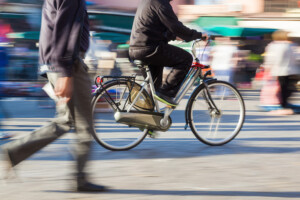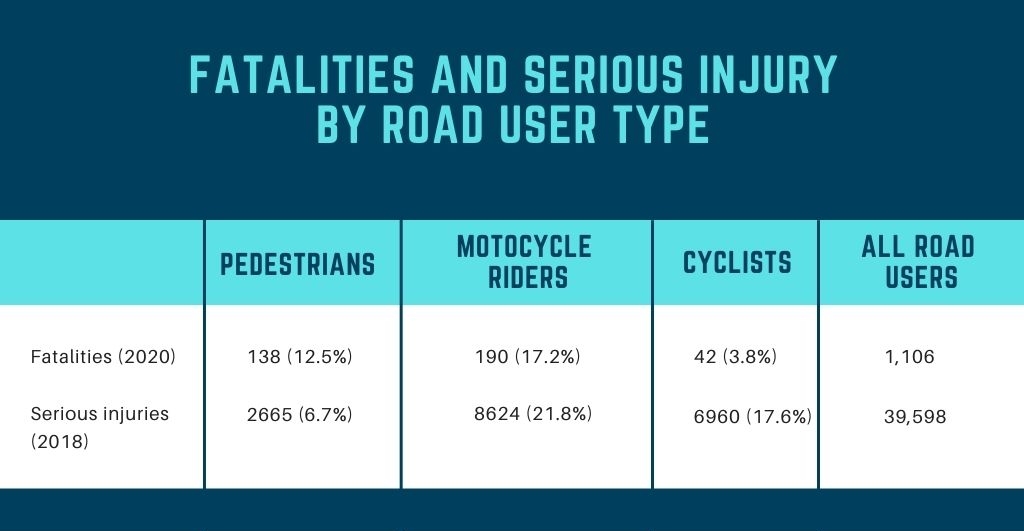29 Apr 2022 | Blog

Cyclists and pedestrians are classed as high risk vulnerable road users.
In the world of transport and road safety, vulnerable road users (VRU) are commonly identified as pedestrians, cyclists, motorcyclists, dog walkers and even road workers. There are three demographic characteristics identified more than most and they include children, people with disabilities and the elderly. The term itself highlights their vulnerability to be easily injured or killed in a car dominated road space. They are considered most at risk because they are unprotected by the enclosed shield of a vehicle and could sustain a greater risk of hurt in any form of collision.
The term ‘mixed traffic’ means that facilities on a roadway are being shared between cars, bikes, and sometimes pedestrians. For safety reasons they tend to be on roads with low volumes of traffic that operate at a much lower speed. An example here could be a cyclist. Roads without cycle tracks added can mean that six out of ten cyclists might experience conflict situations. Parked cars, intersections and other road user behaviour are all common causes of conflict to a cyclist. A cycle track added can reduce that significantly and is a beneficial layer of safety for them.
Slow moving traffic in particular presents a sizeable problem for these types of road users, because anything else on the road at the same time is likely to be moving faster than a vehicle is. Pedestrians & cyclists can easily become hidden in a blind spot which is why for safety reasons it is vital that you check your blind spots before you manoeuvre.
In June 2021 the World Health Organization reported that approximately 1.3 million people die each year as a result of road traffic crashes, and more than half of all road traffic deaths are among vulnerable road users. Fatalities are on an alarming increase and while effective speed mitigation policies have been focused strategies over the years, it’s becoming ever clear that the infrastructure around us also needs to adapt to help save more lives.

source: Road Safety
Vulnerable road user laws are designed to protect road users who are more vulnerable than drivers. They ensure the continued safety of those who commute by pedal or foot, and who work on the roadways. These laws also call for harsher penalties for those who violate them. It can mean higher penalties/jail time or civil lawsuits. It is hoped that drivers will show more caution and safety for others when driving because the violation penalty to do otherwise is extremely high.
Historically, roadway system design has not consistently had vulnerable road users in the forefront of its thought. However, infrastructure and roadway changes do have the ability to address high risk areas for these users and be cost effective at the same time. Improvements, such as traffic calming devices, are becoming more attractive to municipalities and the changing efforts in this space are helping to decrease that dangerous risk. The modification of guardrails for motorcyclists, off road bike paths for cyclists and safe crossing points for pedestrians are all helping to increase their protection, but how can innovative new technology play its part for an overall smarter and safer city?
 NVIDIA’s Annual Conference, GTC 2022, included a panel session called ‘The Making of Smart Cities’. One of our customers, the California Department of Transportation (Caltrans), participated in the panel discussion. Asfand Siddiqui, Sr. Transport Engineer, provided his point of view around city initiatives that aim to solve key challenges such as vulnerable pedestrians, curb, and traffic management, optimizing mobility, understanding public demand, and facilitating better efficiencies for residents:
NVIDIA’s Annual Conference, GTC 2022, included a panel session called ‘The Making of Smart Cities’. One of our customers, the California Department of Transportation (Caltrans), participated in the panel discussion. Asfand Siddiqui, Sr. Transport Engineer, provided his point of view around city initiatives that aim to solve key challenges such as vulnerable pedestrians, curb, and traffic management, optimizing mobility, understanding public demand, and facilitating better efficiencies for residents:
‘Caltrans manage 51,000 miles of highways – there are 40 million people in California, 35 million registered vehicles on the road, 24 million drivers, a lot of fatalities and the task could be daunting at times. Our job is to keep our city safe but also to provide a reliable transportation system. The big issue is of course to detect traffic but it’s also important to detect the vulnerable road users. Of the 3,600 fatalities on California roadways in 2019 – over 900 of them were in this category. We need a system that can detect not just vehicles but pedestrians and bicyclists too.’
With improved transport planning and the commitment to the growing innovation in this space, cities have the opportunity to better meet those needs while solving other more traditional traffic congestion problems. The Palo Alto area currently has a testbed installed on the roadways and its being used to test the effectiveness of new technologies to see how they can improve the safety of vulnerable road users.
 ‘Caltrans is testing this right now with various companies and their new technologies. One that comes to my mind is a company called NoTraffic, they have a sensor that has a camera and a radar unit combined and it can see in conditions where a human eye cannot see. We are trying to detect not only the vehicles but also the vulnerable road users. This is a problem in California that we are looking to address’ – Asfand Siddiqui.
‘Caltrans is testing this right now with various companies and their new technologies. One that comes to my mind is a company called NoTraffic, they have a sensor that has a camera and a radar unit combined and it can see in conditions where a human eye cannot see. We are trying to detect not only the vehicles but also the vulnerable road users. This is a problem in California that we are looking to address’ – Asfand Siddiqui.
The NVIDIA panel agreed that data is necessary to progression in this space and that data collection that can be processed and turned into real-time information is of particular interest.
Recognizing the future of urban mobility is changing, the NoTraffic platform detects and identifies all types of road users – whether it’s a car, emergency vehicle, cyclist, or pedestrian. With safety as a high priority, our traffic management platform optimizes traffic lights in real-time based on smart sensors, AI, and Vehicle-to-Everything (V2X) communication. It helps to improve safety, emissions, and traffic equity in urban areas for all road users, while collecting contextual data, such as speed and wait times.
To learn more about NoTraffic please reach out to the team to schedule an introductory call and demo: meet.us@notraffic.tech